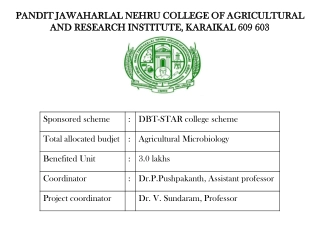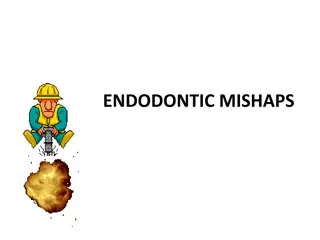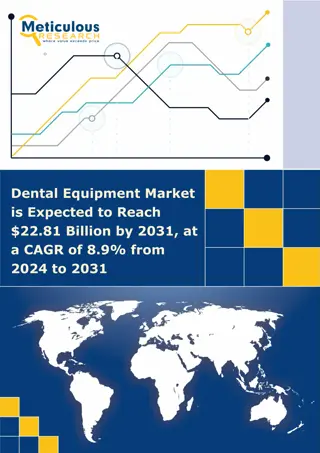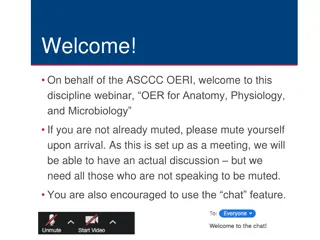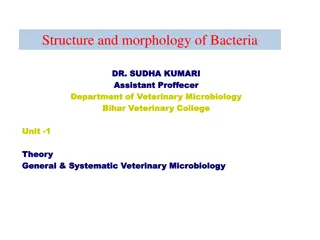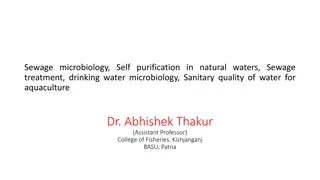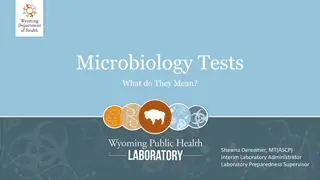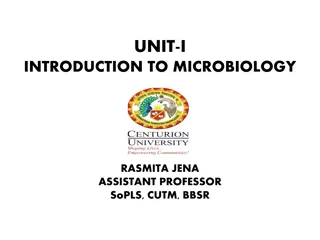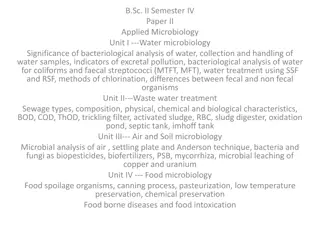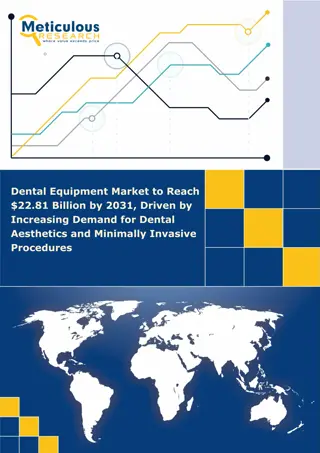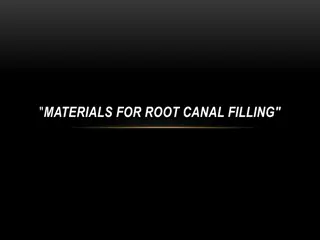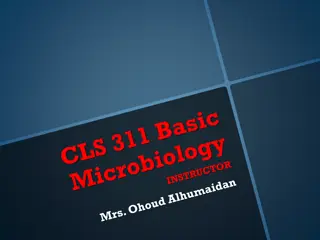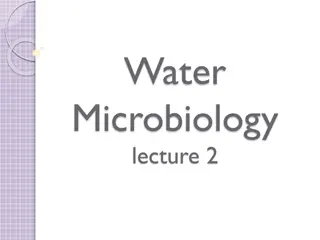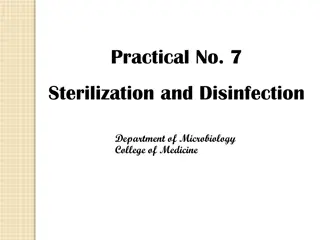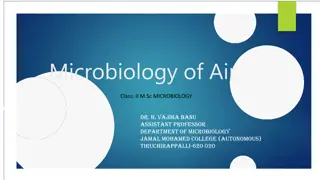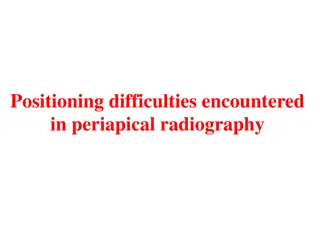
Microbiology in Endodontics - Understanding Root Canal Infections
Explore the intricate world of microbiology within endodontics, focusing on routes of microorganism ingress, types of microorganisms found in root canals, intraradicular and extraradicular infections, and methods for microbial identification. Discover the challenges of cultivating and identifying organisms in endodontic infections and the impact of polymicrobial interactions. Gain insights into the diverse range of invaders in the endodontic complex and how seemingly non-pathogenic species can become invasive and harmful.
Download Presentation

Please find below an Image/Link to download the presentation.
The content on the website is provided AS IS for your information and personal use only. It may not be sold, licensed, or shared on other websites without obtaining consent from the author. If you encounter any issues during the download, it is possible that the publisher has removed the file from their server.
You are allowed to download the files provided on this website for personal or commercial use, subject to the condition that they are used lawfully. All files are the property of their respective owners.
The content on the website is provided AS IS for your information and personal use only. It may not be sold, licensed, or shared on other websites without obtaining consent from the author.
E N D
Presentation Transcript
RUNGTA COLLEGE OF DENTAL SCIENCES & RESEARCH TITLE OF THE TOPIC: MICROBIOLOGY IN ENDODONTICS DEPARTMENT OF CONSERVATIVE DENTISTRY AND ENDODONTICS 1
Specific learning Objectives Specific learning Objectives At the end of this presentation the learner is expected to know Core areas* H Domain ** Category # Routes of microorganism, Microrganism associated with root canal infection Cognitive Must know Intraradicular infection, extraradicular infection Psychomotor Nice to know Methods of identification of microbes Affective Desire to know *Subtopic of importance ** Cognitive, Psychomotor or Affective # Must know , Nice to know & Desire to know 2
TABLE OF CONTENT: TABLE OF CONTENT: INTRODUCTION ROUTES OF MICROORGANISM INGRESS MICROORGANISMS FOUND IN ROOT CANALS ASSOCIATED WITH ENDODONTIC INFECTIONS INTRARADICULAR INFECTION EXTRARADICULAR INFECTION METHODS FOR IDENTIFICATION OF MICROBES 3
MICROORGANISMS FOUND IN MICROORGANISMS FOUND IN ENDODONTIC INFECTION ENDODONTIC INFECTION Polymicrobial interactions and nutritional requirements make the cultivation and identification of all organisms from endodontic infections very difficult. Black pigmented bacteria are currently are the subject of extensive basic science research and clinical studies as the main causative agent of endodontic infections, the severity of such infection, and the resultant clinical symptoms associated with these infections. 4
M.orgs of oral cavity, upper respiratory tract, sinus area, nasopharynx or GIT can gain access to the root canal system, thus the genera and species that must be dealt is vast Invaders of the endodontic complex may not be pathogenic in root canal environment because of change in oxygen and nutrient levels 6
On the other hand, many species that are normal, non pathogenic resident of oral cavity become invasive, destructive, producing toxins and enzymes that causes inflammation, tissue necrosis and infection. 7
Aerobes Aerobes Alpha hemolytic streptococci were the most commonly recovered organisms. Streptococcus mitis and streptococcus salivarius are numerous in oral cavity, as well in infected root canals S. mitis is of particular importance as it is frequently cultured from heart valves after attacks of subacute bacterial endocarditis, therefore proving its pathogenecity in a site remote from the root canal 8
Beta hemolytic and less pathogenic non hemolytic streptococcus were also cultured in large numbers Recent research varifies that there is still great significance in the presence of streptococcus org because of their cell wall components Peptidoglycans and lipoteichoic acids give structural rigidity to the cell wall 9
Osteoclast activating factor and prostaglandins production is a result of peptidoglycan action Immunologically peptidoglycans activate, complement and stimulate B lymphocytes. Lipoteochoic acids enhance the destructive process by inducing bone resorption and immunologically by activating the complement system. Both mediators enhance the pathogenicity and symptoms of infectious disease of the periapical tissue 10
Enterococci, commonly residents of digestive tract, were also commonly recovered in endodontics cultures. Some species such as S. faecalis are difficult to eliminate from endodontic infections because of their resistance to many antimicrobial agents 11
Anaerobes Anaerobes Prior to 1969, very few strains of strict anaerobes were isolated and identified because of inadequate anaerobic culturing methods The importance of anaerobic bacteria in pulpal and periapical pathoses has been revealed with the developing anaerobic culturing methods and use of both selective and non selective culture media 12
However, even with the most sophisticated culture methods, there are still many m.orgs that remain uncultivable Most of the bacteria in an endodontic infection are strict anearobes. These bacteria grow only in the absence of oxygen but vary in their sensitivity to oxygen 13
Facultative anaerobes grow in the presence or absence of oxygen and usually have the enzymes superoxide dismutase and catalase. The dynamics of bacteria in infected root canals have been studied in monkeys. Initially facultative bacteria predominated , however with increasing time, the facultative bacteria were displaced by anaerobic bacteria. 14
The root canal system is a selective habitat that allows the growth of certain species of bacteria in preferance to others Tissue fluid and the breakdown products of necrotic pulp provide nutrients rich with polypeptides and aminoacids. These nutrients, low oxygen tension, and bacterial byproducts determine which bacteria will predominate. 15
Antagonist relationships between bacteria may occur. Some metabolites (eg.., ammonia) may be either a nutrient or a toxin, depending on the concentration In addition bacteria may produce bacteriocins, which are antibiotic like proteins, in order to inhibit another species of bacteria. 16
In 1976, sundquist et al cultured intact root canals of 32 cases. Of the 32 cases, 18 positive cultures were incubated All 18 teeth had periradicular destruction 7 teeth exhibited painfull symptoms & 11 were asymptomatic 17
The striking discovery was that black pigmented anaerobic rods were only present in all 7 symptomatic cases and could not be detected in all 11 teeth without pain Although criticized, the pioneering effort inspired many researchers Baumgartner et al in 1992, cultured the apical 5mm of root canal exposed by caries and found 67% of microbes were strict anaerobes 19
Although no absolute correlation has been made between any species of bacteria and severity of endodontic infection. However several species have been implicated with some clinical sign and symptoms Those species include dark pigmented bacteria, Peptostreptococcus, Eubacterium, Fusobacterium and Actinomycosis 21
Dark pigmented bacteria have been associated with clinical signs and symptoms in several studies. Earlier researches were based on conventional identification of microbes which was based on gram stain, colonial morphology, growth characteristic and biochemical tests. 22
Dark pigmented bacteria ranges from being tan to black colonies depending on the media and environment of incubation in the laboratory Previously , prevotella intermedia was the species of dark pigmented bacteria most commonly isolated from endodontic infection. In 1992, isolated previously thought to be P. intermedia were shown to be closely related species known as P. nigrescens 24
Studies have shown that P. nigrescens is actually dark pigmented bacteria most commonly identified after isolation from both root canal as well as periapical abscess Another study associating dark pigmented bacteria with endodontic infection found them is 55% of 40 intact teeth having necrotic pulp & apical periodontitis 16 of 22 teeth were associated with purulent drainage or associated sinus tract 25
Strains of dark pigmented bacteria previously identified using conventional technique were determined to be P. tannarae. Bystorm et al cultured 140 teeth with nectrotic tissue in root canals and bone destruction in periapical area, and found 80% presence of anaerobic strains with Porphyromonas and Peptostreptococcus 26
Several studies of endodontically treated teeth requiring retreatment have shown a prevalence of facultative bacteria, esp enterococcus faecalis, instead of strict anaerobes Studies using molecular methods have detected numerous other species in root canals that have failed to heal In addition, fungi have been shown to be associated with failed root canals 30
Teaching Materials Teaching Materials Endodontic practices - Grossman Pathways of pulp Cohen Textbook of Endodontics Nisha Garg Endodontics - Ingle 31
TAKE HOME MESSEGE/ FOR THE TOPIC COVERED (SUMMARY) TAKE HOME MESSEGE/ FOR THE TOPIC COVERED (SUMMARY) Infection of the root canal is not a random event. The type and mix of the microbial flora develop in response to the surrounding environment. Microorganisms that establish in the untreated root canal experience an environment of nutritional diversity. In contrast, well-filled root canal offers the microbial flora a small, dry, nutritionally limited space. Thus, we should obtain a better understanding of the characteristics and properties of bacteria and their biofilms along with the environmental changes, to enhance success. 32
Question & Answer Session List microrganisms found in endodontic infection 33
REFERENCES Endodontic practices - Grossman Pathways of pulp Cohen Textbook of Endodontics Nisha Garg Endodontics - Ingle 34
THANK YOU 35

